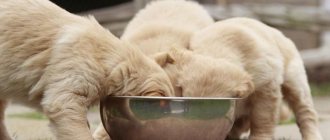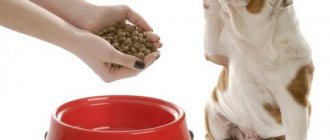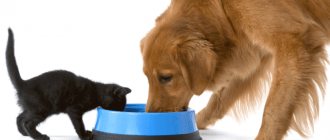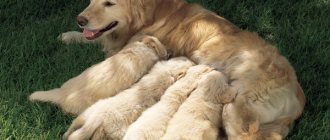The debate about the advantages and disadvantages of ready-made food still continues to this day. There is no clear opinion about which type of nutrition is better. Any diet will have its advantages and disadvantages. But there are times when a pet accustomed to natural porridge has to be transferred to drying. This must be done correctly so as not to cause irreparable harm to the animal’s body.
Why is an animal switched to new dry food?
Each pet is individual, so there are quite a few reasons why your four-legged friend will have to switch to store-bought food.
From another feed
If the animal has already eaten ready-made products, then the main factor in replacing one brand with another is the desire to improve nutrition. Sometimes the owner purchases a more expensive product that contains more useful components or calories.
In some cases, due to a detected disease, a replacement is recommended by a veterinarian. Then the patient can be prescribed a medicinal product that will help normalize health and reduce the burden on the gastrointestinal tract.
For older individuals, large granules are replaced with smaller ones that do not injure their gums and teeth. Typically, elderly pets are given a product labeled Senior.
From natural nutrition
The natural menu has a number of advantages, but it also has a lot of disadvantages. First of all, preparing balanced meals will require a lot of time, which not every person has. It is not always possible to purchase quality products (especially meat) to feed your dog.
Beginning owners lack experience in creating a varied and correct menu. Therefore, at the first opportunity, they try to switch the puppy to dry feeding. And some pets need a specialized diet, which is very difficult to adhere to due to the complex ratio of components.
Ready-made granules are also indispensable during long trips, when it is quite difficult to find fresh ingredients for porridge or soup. If an animal often accompanies its owner on trips, it is better to accustom it to drying.
How to switch a dog to dry food from natural
Veterinarians note that the correct selection of the product and the owner’s patience are the main components of success when transferring a dog from natural food to dry food.
Procedure
You cannot suddenly transfer a pet from one type of menu to another. This is dangerous not only for the digestive system, but for the emotional state. The pet does not understand what is happening and why the contents of the plate that are familiar to him are changing.
Veterinarians recommend following a certain scheme that will help make the transition more gentle:
- The best way to introduce your dog to “drying” is to offer him a couple of granules as a treat from the palm of your hand.
- For the first 3-5 days, it is recommended to use only a quarter of the purchased granules; the rest of the diet remains natural.
- Over the next 3 days, you need to bring the content of the industrial mixture in the bowl to half.
- On days 10-14, “drying” will make up 100% of the pet’s menu.
It is important to remember that you cannot mix fresh and prepared ingredients in the same plate. This is allowed only if the four-legged dog categorically refuses to try store-bought pellets. To get accustomed to the smell and taste of new food, “drying” is added to the porridge, gradually increasing its concentration and removing natural ingredients from the menu.
After a complete transition to food, you must ensure that the portion sizes correspond to those recommended on the packaging. In cool weather, outdoors and indoors, pour 10% more than the specified amount into the bowl. In hot weather, the portion is slightly reduced.
If the animal refuses to “dry”
There are times when an animal accustomed to meat does not agree to other food. Then experienced breeders recommend changing the brand of the mixture to a more expensive analogue, which contains more natural ingredients familiar to the dog.
You can try buying a package with a different flavor if you are more picky. You may have to try more than one option, and then the process may take longer. But the huge assortment in pet stores will ultimately allow you to choose something that your four-legged friend will like.
Sometimes a trick helps - wet canned food is used as an intermediate option. They help the dog realize that not only meat is tasty and aromatic. But this method also has a disadvantage: subsequently you will have to try to transfer your pet from wet food to dry food.
Transfer to wet food
Most often, the transition to wet food takes place without any difficulties. Most dogs enjoy eating canned food because it has a rich smell and taste. However, a pet's desire to eat treats and its ability to digest unusual food are completely different concepts.
Problems can arise with puppies trying solids for the first time. Most puppies instinctively consider cold food inedible. To correct the situation, canned food should be warmed up a little before serving or diluted with hot water. The optimal food temperature is considered to be between 35 and 38 degrees.
Straight
It will take 2-3 days to switch a dog from natural food to canned food. On the first day, grind the canned food until smooth. It is advisable to grind in a blender with the addition of a small amount of warm water.
The resulting mass is added to the usual porridge. Replacement begins with 30% of the daily feed intake. Next, you need to act in accordance with the interests of the pet. If a dog is physically unable to consume solid food, its diet consists only of canned food. If the pet chews food without problems, the diet consists of canned food and dry food of the same brand and line.
From dry food
Transferring dry food to canned food usually occurs without any difficulties. In rare cases, it may be necessary to soak dry kibble and mix it with new, canned food.
Transfer from another canned food is carried out using the method of gradual substitution. Mix the usual and new food, increasing the concentration of the latter from 30 to 100%. Usually, switching to another wet food, if its quality is not lower than that of the usual one, takes place without any problems.
READ Hypoallergenic cat food: rating, selection rules
How to switch your dog to another dry food
Sometimes the usual store-bought mixtures no longer appeal to picky eaters or cause eating disorders in the form of allergies or constipation. Then the owner thinks about changing the dry product.
The transition from one product to another should not be abrupt. Here, just as with the natural menu, you should act in stages:
- The first three days - new food is introduced into the usual food in a volume of 25% of the norm.
- On days 4-6, your pet’s bowl should contain equal amounts of familiar and new food.
- Days 7-9 – the share of usual food by this time is no more than 15%.
- By the end of the second week, 100% of the serving volume should come from the new food.
Granules from different manufacturers or brands are mixed in one bowl and only then given to your four-legged friend. During this period, it is important to monitor the dog’s health. Short-term problems with the gastrointestinal tract are a reason not to introduce other foods too quickly. It may be necessary to stretch out the transfer time a little and reduce the percentage of new granules.
If allergies, severe constipation or diarrhea occur, you should abandon the innovation and look for a replacement. It may be worth trying products designed specifically for allergy sufferers or animals with sensitive digestion.
How to switch a puppy to dry food
The digestive organs of babies are not yet able to fully cope with heavy food loads. Therefore, you should be especially careful when switching your puppy to dry food.
Typically, babies begin to watch what their mother eats and taste the contents of the bowl at the age of 3-4 weeks. From this time on, complementary foods can be introduced using granules soaked in water or store-bought pates. This gruel is given gradually, and its volume should be one fifth of that recommended on the package.
For the first time, the owner dips his finger into the prepared pulp and lets the puppy lick it off. You can gently lower his face into the bowl. The remaining food is given to the mother female.
On the next and subsequent days, the portion is increased, making the porridge less liquid. This way the baby will get used to semi-moist food, and then will be happy to eat the store-bought product. A complete switch to granules is recommended by the time the puppy's baby teeth begin to change to permanent ones.
It should be remembered that only premium, super-premium and holistic-class products are suitable for feeding babies. Food should be appropriate for the age of the puppies and not contain large granules.
Conversion from dry food to canned food
There is also the exact opposite situation, when the baby needs to be transferred from “drying” to high-quality canned food. Many breeders in this case do not see any problem at all, since de facto they consider canned food to be of higher quality and healthier, but this is not entirely true.
We would strongly recommend switching puppies only to Premium or Super Premium food.
Economy class canned food is far from the best choice even for adult dogs, not to mention puppies.
When to abandon the idea of translation?
Some pets' bodies react poorly to industrially produced food. If changing the brand and monitoring your pet does not help, then it is better to completely abandon the transition to a dry type of food.
Individuals over 5 years old do not respond very well to changing the menu. Their digestive organs have difficulty adapting to new ingredients, so there is a risk of chronic constipation, pancreatitis or other gastrointestinal problems.
Another reason to avoid drying is an allergic reaction. It can be caused by individual components contained in purchased food. In this case, the owner will have to consult a veterinarian and return to the dog’s usual diet.
Transferring puppies to special food
What are special feeds in principle? These are understood as diets developed and used for feeding animals in the following cases:
- Special diets for animals with white fur, for example. Such animals are more susceptible to developing metabolic disorders, which is why their diet should be special.
- This also includes diets specially created for puppies of large, medium, small and dwarf breeds. These pets have significantly different metabolisms and needs, and therefore should not feed them the same food.
- Foods created and used for feeding puppies of different ages. They are also used for a reason, because for children at different ages, the body’s needs for nutrients, micro and macroelements, vary significantly.
- Feeds enriched with dietary fiber, containing prebiotics, etc. Used in cases where the puppy has some kind of digestive problems.
- Therapeutic diets used to feed puppies suffering from certain diseases.
The principles for transferring puppies to all these diets are exactly the same as in the cases described above.
But if for some reason your pet needs food with a medicinal effect, you must consult a veterinarian before using it!
Useful tips
Few people know that dehydrated pieces of meat in the diet of animals appeared 160 years ago in 1860. There is still debate about the disadvantages and advantages of this product.
Feed selection
Only those owners who purchased economy-class products for their pets could have a clearly negative opinion about industrial food. It contains components that are useless for regular consumption: soy, cereals, offal instead of meat. The attractive aroma of the lumps is created using chemical flavors and flavor enhancers.
When choosing a product, you should give preference only to high-quality products and a trusted manufacturer. It is important to carefully study the composition on the packaging. The following components should be listed there:
- fresh and dehydrated meat;
- eggs;
- vegetables and fruits, sometimes seaweed;
- fish fat;
- amino acids;
- cereals;
- vitamin and mineral complex.
Eating such granules will not only not harm your pet, but will also bring him benefit and satiation. Super-premium and holistic products do not require additional vitamins and microelements to be added to the menu.
We must not forget about the age and size of the individual. For example, a small breed dog or an elderly individual is unlikely to cope with large pieces of food intended for large breeds of animals.
Drinking regime
When using “drying”, the animal needs constant access to clean drinking water more than ever. It is necessary for the balance of nutrients in the body and normal digestion. Water should be next to the food plate so that your friend can quench his thirst not only after eating, but at any time.
How to switch your dog to natural food
Converting a dog to natural breeding is not at all easy. The main danger is insufficient or unbalanced nutrition. Ready-made food takes into account the dog’s needs for all microelements, but it will be difficult to do this on your own. An approximate diet for a dog might look like this: 40-50% meat, 30% fermented milk products and the rest is fiber. For example, it could be cottage cheese and kefir with bran in the morning and meat in the evening. Periodically treat with vegetables and fruits. It is also necessary to gradually transfer the dog to the natural diet, monitoring the dog’s well-being.
Read more about the nutrition and needs of pets in the article “How to feed dogs”











